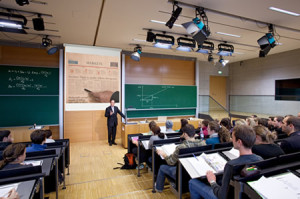The Current (Future) State of Audiovisual Technology in Higher Education
The Current (Future) State of Audiovisual Technology in Higher Education
 Audiovisual technology, like a brisk autumn breeze, has spread through higher education, changing the instructional landscape. Much has been written, weighing its pros, its cons, and what the future holds. A recent article in New Bay Media’s AVNetwork, The Current State of Audiovisual Technology in Higher Education is a case in point. The author encapsulates what he sees as the current state, praising the new flexible modes AV technology makes possible — the flipped classroom, distance learning, and lecture capture. At the same time he points out that complex systems and interfaces intimidate some educators, making them reluctant to explore the newest audiovisual technology. That very same new technology also presents a dilemma to administrators held accountable for choosing solutions that very well may be replaced by the new kid on the block next year.
Audiovisual technology, like a brisk autumn breeze, has spread through higher education, changing the instructional landscape. Much has been written, weighing its pros, its cons, and what the future holds. A recent article in New Bay Media’s AVNetwork, The Current State of Audiovisual Technology in Higher Education is a case in point. The author encapsulates what he sees as the current state, praising the new flexible modes AV technology makes possible — the flipped classroom, distance learning, and lecture capture. At the same time he points out that complex systems and interfaces intimidate some educators, making them reluctant to explore the newest audiovisual technology. That very same new technology also presents a dilemma to administrators held accountable for choosing solutions that very well may be replaced by the new kid on the block next year.
His points are well-taken, however, necessity is the mother of invention, and in this case something has to give. Universities are faced with ever-rising costs yet students already have taken on historic loads of debt. Perhaps private institutions of higher education and larger universities need to look to the experience of community colleges. Community college districts usually have several campuses. Administrators weighed the expense of staffing separate classrooms with that of paying one instructor to deliver the same content to all via distance learning — mirrored content or lecture capture and streamed video. As a result they have been offering flexible network-based or wireless delivered instruction for years.
There’s no disputing that the rapid evolution of ever-new technological solutions makes the decision of investing in any one a gamble. However, it’s inevitable that with so many network solutions available — streaming video, cloud solutions, inexpensive standards base video conferencing, HD baseT –the campus of the future may center around a screen rather than a campus.
As for wireless delivery, if only someone can come up with a technology that offers the flawless consistency of the iPad, already used and beloved by so many educators, that would solve the problem of confusing interfaces. Many instructors already combine iPad and Apple TV to share mirrored content wirelessly. The InFocus MondoPad with its large flat panel screen and key tools like a PC, annotation software, wireless connectivity, standards based videoconferencing and multiple interface applications already built into it gaining tremendous popularity. The cost savings in simple installation, seamless integration, an intuitive interface and cross-platform abilities make it one of the best value propositions on the market, particularly if you’re unsure of the direction of technology. Combine the Mondopad with a simple intuitive interface for streaming and recording video, and you have everything you need for the classroom of the future.







